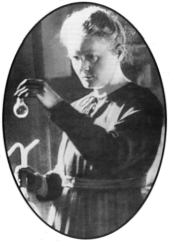www.physics.ucla.edu/~cwp/images/curie-sm.gif
Marie Curie
Life is not easy for any of us. But what of that? We must have perseverance and, above all, confidence in ourselves. We must believe that we are gifted for something, and that this thing, at whatever cost, must be attained. - Marie Curie
Marie Curie is one of the most well known women scientists. Marie was born in Warsaw, Poland in 1867. Even through the death of her mother and a sister before she was 11, Marie still managed to graduate from high school at the age 15 with the highest honors. In 1891, she moved to Paris to attend Sorbonne University. While obtaining a physics and mathematics degree, she was introduced to Pierre Curie, a physics professor at the university. They fell in love and were married a few years later in July 1895. But only nine years later in April 19, 1906, Pierre was killed in an accident leaving Marie alone to take care of the family and continue their research. In 1914, when the World War started, Marie decided that she wanted to help out with the war effort using her science. Knowing that x-rays out in the war field could save many lives, she created mobile x-ray stations and trained females to be able to work them. Marie lived a very selfless life by always working hard and always trying to figure out how she could help others.
Contribution to Physics:
Marie and her husband Pierre discovered two radioactive (which was a term that Marie made up) substances, radium and polonium. Which then led to Marie being the first female to be awarded a Nobel Prize in 1903.
Other Achievements and Awards:
Gave birth to her daughter, Irene in September 1897.
In July 1898, Marie and Pierre published a paper revealing their discovery of radium and polonium.
1900- Became the first woman faculty member at one of the top training schools for women teachers in France.
In 1903, completed her doctoral thesis, and became the first woman to receive a doctorate in France.
After Pierre's death in 1906, Marie took over his job at Sorbonne and became the first woman professor there.
Established a scientific institution in Pierre’s memory, the Radium Institute.
In 1911, Marie became the first person to win a second Nobel Prize. She won a Nobel Prize for Chemistry for her determining the atomic weight of radium and polonium.
Created the mobile x-ray stations and saved many lifes in the World War.
On July 4, 1934, Marie Curie died of a blood disease that often results from too much exposure to radiation.
